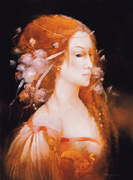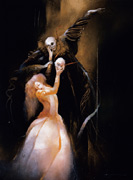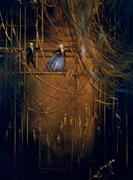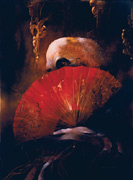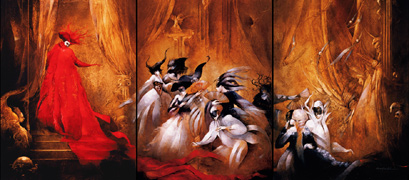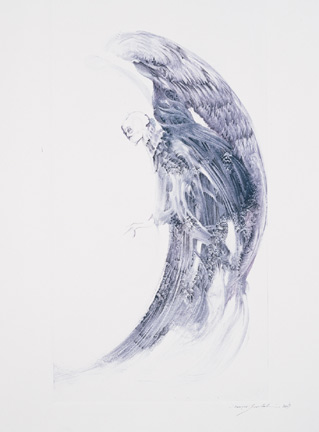|
"Anne Bachelier Rescues
the Phantom of the Opera from Andrew Lloyd Weber"
by Ed McCormack
One reviewer called Andrew Lloyd Webber’s staging
of The Phantom of the Opera “a victory of pseudo-populist grandiosity
over taste –– an act of cultural butchery akin to turning
an aviary of graceful swans and brilliant peacocks into an order
of Chicken McNuggets.”
Those of us who grew up on the old black and white film starring
Lon Chaney and were not tempted by it to investigate any of the
subsequent stage or film versions, much less the book, can only
be grateful to Neil Zukerman, publisher and designer of CFM books,
for returning Gaston Leroux’s 1910 novel to the page in a deluxe
format illustrated by the inimitable French painter Anne Bachelier.
In fact, since Zukerman is also the director of CFM Gallery, 112
Greene Street, in Soho, and Bachelier is his star artist, there
are several copies priced by degree of deluxeness, the most unique
being those that include original illustrations in ink or oil paper
illustrations by the artist. However, the standard edition, hard
bound in black silk with a pictorial dust jacket, is sufficiently
elegant to qualify as an object of art unto itself.
For even if she had never exhibited her somewhat Surrealist, somewhat
Symbolist, but ultimately unclassifiable oils on canvas in galleries,
Bachelier would have become known as perhaps our greatest living
illustrator. And the same must be said of Zukerman: Had he never
opened a gallery pugnaciously championing figurative when abstract
painting still ruled Soho, he could certainly have attained a reputation
as perhaps the last great publisher of not “bookworks”
but authentic livres d’artistes.
But what does it mean to be a great illustrator at a time when real
illustration has all but been replaced by Photo Shop manipulation,
or to be a great publisher in an era of Oprah’s Book Club and
a bestseller list filled with diet books and celebrity biographies?
That Zukerman and Bachelier have been too busy creating beautiful
books to consider the full ramifications of this question seems
to me a mercy. For the pair has given us superb volumes such as
Princess of Wax, and Rose Daughter (A Retelling of Beauty and the
Beast), as well as the only edition of Lewis Carroll’s Alice’s
Adventures in Wonderland really worth looking at since the 1865
edition illustrated by Sir John Tenniel. And their Phantom is arguably
their most successful collaboration to date.
For one thing, Zukerman has contributed a synopsis that reads like
a well-written libretto. Thus those of us who are still disinclined
to slog through more of Leroux’s overburdened prose than can
be sampled in the skillfully excerpted character introductions Zukerman
has also thoughtfully provided, can connect Bachelier’s illustrations
to the proper points in the text without suffering post-Victorian
mind-clog. But even more important, he has designed a book that
serves as a plush jewel-box for her peculiar imagistic genius.
Generous areas of white space set off the exquisiteness of Bachelier’s
spare ink drawings, wherein she combines sinuous strokes of gray
wash, laid down boldly with a broad brush in the manner of Asian
calligraphy, to arrest the eye and direct it to the meticulous pen-work
with which she delineates the main characters. Sumptuous full-page
color spreads are devoted to her narrative illustrations in oil
on gessoed paper.
|
The latter are as elaborately wrought as her
fine art compositions in oil on canvas. However, what makes
Bachelier a superb illustrator, rather than a mere slummer
in a “lesser” area (a too common attitude when painters
condescend to trample the life out of a narrative with their
overbearing styles and egos) is how thoroughly she gives herself
over to the text. Happily, this text reciprocates in kind,
giving its atmospheric riches over to the illuminating ministrations
of her brush like a lover grateful to have finally found its
true mate.
Indeed, not once does Bachelier betray any knowledge of possessing
greater mastery of her own art than Leroux had of his. Such
is her innate modesty that she revels in his guttering candles,
crystal chandeliers, shadowy corridors, relishing the opportunities
they afford to indulge her love of chiaroscuro.
Every element in the story seems tailored to
her talents: The dizzying heights of the Paris Opera House’s
backstage rafters with their trapeze-like ropes and riggings,
so like the theatrical settings of her paintings; the masks
and opulent costumes, so like those of the characters born
of her own imagination; the novel’s beautiful heroine,
Christine, with her delicate features and ivory skin so like
those of a classic Bachelier ingenue; the Phantom himself,
perhaps the most formidable among the many male grotesques
that have courted, stalked, and menaced many of the female
protagonists of her painted tableaux over the years ––
all reciprocate the artist’s humility by offering her
an opportunity to crystalize, rather than subjugate, her singularly
imaginative aesthetic vision.
|
|
If one had to choose a favorite illustration from among the many
magnificent pictures it this book, it would probably be “The
Phantom’s Masked Ball,’’ the image most like some
of Bachelier’s most memorable oils on canvas. Such scenes of
costumed revelry seem to have grown ever more prominent in Anne
Bachelier’s oeuvre in the years since Neil Zukerman started
coaxing the artist and her husband, Claude, out of their customary
domestic seclusion in Grenoble, to join him and his partner, Tom,
in an annual jaunt to Venice for Carnivale. Through this annual
tradition, it would appear that the enterprising art dealer has
provided his favorite artist with yet another avenue of inspiration
that bears rich fruit in this their latest collaboration. ––
Ed McCormack
From Gallery & Studio, Vol. 11, No. 4. April/May 2009
For more information visit www.galleryandstudiomagazine.com.
|





















